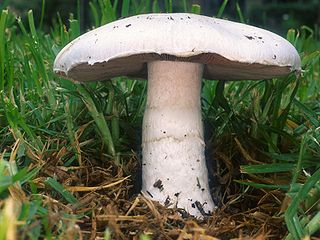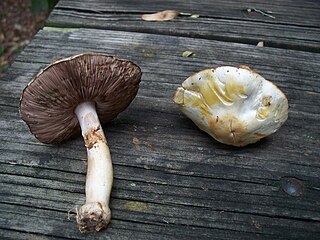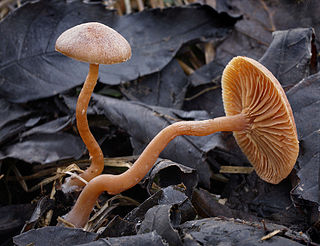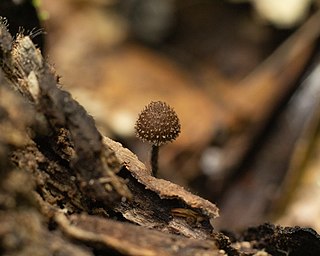
The Agaricaceae are a family of basidiomycete fungi and include the genus Agaricus, as well as basidiomycetes previously classified in the families Tulostomataceae, Lepiotaceae, and Lycoperdaceae.

Agaricus is a genus of mushroom-forming fungi containing both edible and poisonous species, with over 400 members worldwide and possibly again as many disputed or newly-discovered species. The genus includes the common ("button") mushroom and the field mushroom, the dominant cultivated mushrooms of the West.

Agaricus subrufescens is a species of mushroom, commonly known as almond mushroom, almond agaricus, mushroom of the sun, God's mushroom, mushroom of life, royal sun agaricus, jisongrong, or himematsutake. A. subrufescens is edible, with a somewhat sweet taste and a fragrance of almonds.

Agaricus campestris is a widely eaten gilled mushroom closely related to the cultivated A. bisporus. A. campestris is commonly known as the field mushroom or, in North America, meadow mushroom.

William Alphonso Murrill was an American mycologist, known for his contributions to the knowledge of the Agaricales and Polyporaceae. In 1904, he became the assistant Curator at the New York Botanical Garden (NYBG). He, along with the NYBG, founded the journal Mycologia and was its first editor for 16 years. Murrill was known to travel extensively to describe the mycota of Europe and the Americas. He traveled along the East Coast, Pacific Coast, Mexico and the Caribbean. Although Murrill was a very influential person at the NYBG, having worked his way up to become assistant director in 1908, his rather eccentric personality caused problems with his job. He went on annual collecting trips to Mexico, the Caribbean, Europe, and South America, sometimes, without informing any of his colleagues prior. These trips resulted in a cumulative total of 70,000 specimens, 1,400 of which are deposited in the NYBG.

Agaricus abruptibulbus is a species of mushroom in the genus Agaricus. It is commonly known as the abruptly-bulbous agaricus or the flat-bulb mushroom. First described by the mycologist Charles Horton Peck, this bulbous-stemmed edible species smells slightly of anise or bitter almond, and turns yellow when bruised or cut. The mushroom is medium-sized, with a white, yellow-staining cap on a slender stipe that has a wide, flat bulb on the base.

Exsudoporus frostii, commonly known as Frost's bolete or the apple bolete, is a bolete fungus first described scientifically in 1874. A member of the family Boletaceae, the mushrooms produced by the fungus have tubes and pores instead of gills on the underside of their caps. Exsudoporus frostii is distributed in the eastern United States from Maine to Georgia, and in the southwest from Arizona extending south to Mexico and Costa Rica. A mycorrhizal species, its fruit bodies are typically found growing near hardwood trees, especially oak.
Gymnopilus weberi is a species of mushroom in the family Hymenogastraceae. Found in North America, it was described as new to science in 1946 by mycologist William Alphonso Murrill.

Agaricus deserticola, commonly known as the gasteroid agaricus, is a species of fungus in the family Agaricaceae. Found only in southwestern and western North America, A. deserticola is adapted for growth in dry or semi-arid habitats. The fruit bodies are secotioid, meaning the spores are not forcibly discharged, and the cap does not fully expand. Unlike other Agaricus species, A. deserticola does not develop true gills, but rather a convoluted and networked system of spore-producing tissue called a gleba. When the partial veil breaks or pulls away from the stem or the cap splits radially, the blackish-brown gleba is exposed, which allows the spores to be dispersed.

Carleton Rea was an English mycologist, botanist, and naturalist.

Tubaria is a genus of fungi in the family Tubariaceae. The genus is widely distributed, especially in temperate regions. Tubaria was originally named as a subgenus of Agaricus by Worthington George Smith in 1870. Claude Casimir Gillet promoted it to generic status in 1876. The mushrooms produced by species in this genus are small- to medium-sized with caps ranging in color from pale pinkish-brown to reddish-brown, and often with remnants of the partial veil adhering to the margin. Mushrooms fruit on rotting wood, or, less frequently, in the soil. There are no species in the genus that are recommended for consumption.
Amanita virosiformis, commonly known as the narrow-spored destroying angel, is a poisonous basidiomycete fungus, one of many in the genus Amanita. Originally described from Florida, it is found from coastal North Carolina through to eastern Texas in the southeastern United States.

Agaricus hondensis, commonly known as the felt-ringed agaricus, is a species of fungus in the family Agaricaceae. The species was officially described in 1912 by mycologist William Alphonso Murrill, along with three other Agaricus species that have since been placed in synonymy with A. hondensis. Found in the Pacific Northwest region of North America, A. hondensis fruits in the fall under conifers or in mixed forests.

Cystoagaricus is a genus of fungi in the family Psathyrellaceae. The genus contains four species found in subtropical America. The genus was circumscribed by mycologist Rolf Singer in 1947, with Cystoagaricus strobilomyces as the type species.

Charles Christopher Frost was an American mycologist. He described several species of fungi from the New England area of the United States. In one paper, Frost described 22 new species of boletes, and he was later credited with the discovery of three additional species. His personal herbarium of specimens were given to the University of Vermont in 1902. Portions of his collection today are distributed between the Farlow Herbarium at Harvard University, the New York State Museum, the Bell Museum of Natural History, and the Buffalo Museum of Science.

Volvariella bombycina, commonly known as the silky volvariella, silky sheath, silky rosegill, silver-silk straw mushroom, or tree mushroom, is a species of edible mushroom in the family Pluteaceae. It is an uncommon but widespread species, having been reported from Asia, Australia, the Caribbean, Europe, and North America. The fruit body (mushroom) begins developing in a thin, egg-like sac. This ruptures and the stem expands quickly, leaving the sac at the base of the stem as a volva. The cap, which can attain a diameter of up to 20 centimetres, is white to slightly yellowish and covered with silky hairs. On the underside of the cap are closely spaced gills, free from attachment to the stem, and initially white before turning pink as the spores mature. The mushroom grows singly or in clusters, often appearing in old knotholes and wounds in elms and maples. V. bombycina contains compounds with antibacterial properties.

Tricholoma floridanum is a mushroom of the agaric genus Tricholoma. It was first formally described by William Alphonso Murrill in 1945.

Cystoagaricus strobilomyces is a species of mushroom producing fungus in the family Psathyrellaceae and the type species of the Cystoagaricus genus
Amanita hygroscopia, also known as the pink-gilled destroying angel is a deadly poisonous fungus, one of many in the genus Amanita.















